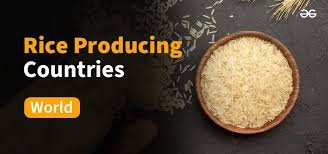The Top 10 Rice Producing Countries in the World: A Comprehensive Overview
Rice, the staple food for a significant portion of the world’s population, holds immense importance in global agriculture. Understanding the dynamics of rice production is crucial not only for agricultural economists but also for aspirants preparing for various government exams. In this article, we delve into the top 10 rice-producing countries, shedding light on their contributions to global rice production.
Rice, a fundamental food crop, plays a vital role in ensuring food security for billions of people worldwide. The production of rice is not only a significant economic activity but also a cultural cornerstone in many societies.
China: Leading the Way China, often referred to as the “Rice Bowl of the World,” holds the top position in rice production. With its vast agricultural lands and advanced farming techniques, China has consistently maintained its dominance in global rice production.
India: Following Closely India, the second-largest producer of rice, boasts diverse agro-climatic conditions conducive to rice cultivation. The country’s rich cultural heritage is intricately linked with rice cultivation practices, making it a key player in the global rice market.
Why this News is Important:
Rising Global Demand for Rice: As the world’s population continues to grow, the demand for staple foods like rice is expected to surge. Understanding the top rice-producing countries equips aspirants with valuable insights into the global food landscape and the challenges of ensuring food security for all.
Impact on International Trade: The production trends of major rice-producing countries directly influence international trade dynamics. Aspirants need to grasp the economic implications of these trends, especially in the context of trade policies and agreements governing agricultural commodities.
Socioeconomic Significance: Rice cultivation is not just an agricultural activity; it is deeply intertwined with the socioeconomic fabric of many nations. Exploring the top rice-producing countries sheds light on issues such as rural livelihoods, income inequality, and rural-urban migration patterns.
Historical Context:
Rice Cultivation Through the Ages: Rice cultivation dates back thousands of years, with evidence of its domestication found in ancient civilizations such as Mesopotamia, China, and the Indian subcontinent. Over centuries, rice has evolved from a wild grass to a staple food crop, shaping the agricultural practices and dietary habits of diverse cultures.
Green Revolution and Rice Production: The Green Revolution of the mid-20th century revolutionized rice production through the introduction of high-yielding varieties (HYVs), irrigation technologies, and agrochemical inputs. This period witnessed a significant increase in global rice yields, transforming the agricultural landscape of many countries.
Modern Challenges in Rice Production: Despite technological advancements, rice cultivation faces numerous challenges in the 21st century, including climate change, water scarcity, soil degradation, and pest infestations. Addressing these challenges requires innovative approaches and sustainable practices to ensure the long-term viability of rice production systems.
Key Takeaways from “Top 10 Rice Producing Countries in the World”:
| Serial Number | Key Takeaway |
|---|---|
| 1. | China holds the top position in global rice production. |
| 2. | India follows closely as the second-largest producer. |
| 3. | Indonesia, Bangladesh, and Vietnam are other leading producers. |
| 4. | Emerging economies like Brazil and Nigeria show promising growth in rice production. |
| 5. | Understanding the dynamics of rice production is essential for aspirants preparing for government exams in agriculture-related fields. |
Important FAQs for Students from this News
1. How does rice production contribute to global food security?
- Rice production plays a crucial role in ensuring food security for a significant portion of the world’s population, especially in regions where rice is a staple food. Understanding the dynamics of rice production helps policymakers in formulating strategies to address food security challenges.
2. What are some challenges faced by rice-producing countries?
- Rice-producing countries face various challenges, including climate change, water scarcity, soil degradation, and pest infestations. These challenges impact both the quantity and quality of rice production, necessitating sustainable farming practices and innovative solutions.
3. How do trade dynamics affect rice production?
- International trade dynamics significantly influence rice production patterns, prices, and market stability. Changes in trade policies, tariffs, and global demand can have profound implications for rice-producing countries and their economies.
4. What is the role of government policies in rice production?
- Governments implement policies and strategies to support rice production, ensure food security, and promote agricultural sustainability. These policies may include subsidies, incentives, research and development initiatives, and trade regulations.
5. How has technology shaped modern rice production?
- Technological advancements, such as high-yielding varieties (HYVs), irrigation systems, and precision farming techniques, have revolutionized rice production. These technologies have enabled farmers to increase yields, reduce environmental impact, and improve efficiency.

